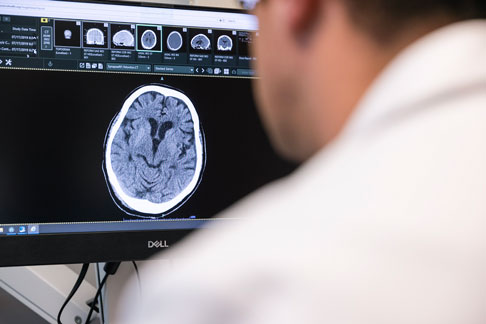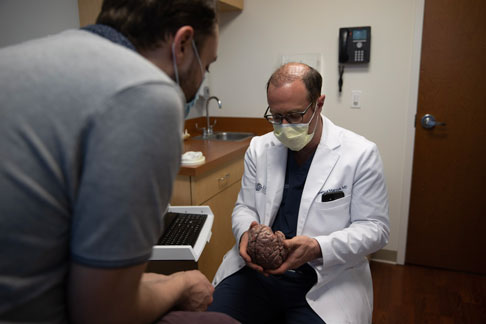Brain Condition Specialists
Neurosurgical Care Powered By Decades of Experience
Patients and their families can expect personalized treatment for complex, traumatic, or chronic brain conditions and injuries from board-certified, local neurosurgeons.
Specialty Focus on Complex Brain Conditions

Diseases and conditions of the brain and nervous system are among the most complex–your long-term relief is our top priority. Through the latest advancements in surgical technology and scientific research, our team successfully treats a multitude of brain conditions, including brain tumors, chiari malformations, strokes, and many others.
Receive The Best Treatment Possible For:
Arachnoid Cyst
An Arachnoid Cyst is a type of cyst that forms around the membrane in the brain or spine. The cysts are small fluid-filled sacs. Usually these cysts are present at birth, however they can occur if you experience trauma to the brain or spine.
Although there has been no defined cause of these cysts, family history of these cysts increases the likelihood of cysts in children. Many arachnoid cysts will not cause symptoms and will not need treatment. However, there are some cases where the cysts require treatment if the cyst grows and causes neurological symptoms.
Symptoms
- Headache
- Nausea
- Vomiting
- Seizures
- Changes in behavior
- Delayed mental development
- Hydrocephalus (fluid around the brain)
- Vertigo
- Vision or hearing problems
- Visible protrusions on the head or spine
Treatment
If you have an arachnoid cyst, it will be monitored over time if you show signs of symptoms. Your Elite Brain and Spine surgeon will discuss surgical options to remove or decrease the size of the cyst. Two of the most common surgical options our surgeons perform on arachnoid cysts include a craniotomy or placing a shunt. A craniotomy is when a small hole is made in the back of a skull to drain the cyst and to increase flow of the cerebrospinal fluid. A shunt is a tube placed into the cyst and stays there to drain the cyst. Your spine surgeon will discuss the best approach with you depending on your cyst.
Arteriovenous Malformations (AVM)
An arteriovenous malformation is an abnormal tangle of blood vessels connecting veins and arteries that disrupts normal blood flow and oxygen circulation. The arteries are responsible for taking oxygen rich blood from the heart to the brain and veins carry the oxygen depleted blood back to the heart and lungs. When there is an AVM, it disrupts this circuit causing the surrounding tissues to not get enough oxygen. Since the blood vessels are considered abnormal, it can cause them to weaken and rupture. If an AVM does rupture, it can cause bleeding in the brain, stroke or brain damage.
The cause of AVMs is not clear. There does not seem to be a strong hereditary component, however they can be caused by birth defects and get worse as the child ages.
Symptoms
- Headaches
- Hemorrhages
- Seizures
- Strokes
- Difficulty with memory, speech or cognition
- Difficulty seeing or hearing
- Muscle weakness
- Muscle paralysis
Seek treatment as soon as possible if you are experiencing any of these conditions with one of the neurosurgeons at Elite Brain and Spine. We have the top neurosurgeons in Connecticut and are experts at treating AVMs. Your symptoms may become worse if you delay treatment.
Treatment
Our top neurosurgeons at our brain and spine center have treated thousands of patients with these malformations and the patients have been able to live very healthy lives. Noninvasive and minimally invasive treatment options are usually used to treat these malformations. These options include Embolization and Stereotactic Radiosurgery. If one of these procedures does not provide enough relief for the patient, your spine specialist may suggest surgery to treat the AVM. This surgery is known as Arteriovenous Malformation Resection which is when your surgeon will use a small incision and small surgical instruments to remove or repair the malformation.
Brain Aneurysms
A brain aneurysm is a balloon or bulge in a blood vessel in the brain. There can be two types of anyresums: ruptured and unruptured aneurysms.
Risk Factors
These factors may increase your risk of having a brain aneurysm:
- Smoking
- High blood pressure
- Drug use (particularly cocaine)
- Family history of brain aneurysms
- Polycystic kidney disease
- Marfan’s syndrome
- Arteriovenous (artery and vein) malformations (AVMs)
Ruptured Aneurysms
A ruptured aneurysm is a life-threatening condition that can cause a severe brain injury or even death. Once the aneurysm ruptures, it causes bleeding between the skull and brain (a subarachnoid hemorrhage).
If you are experiencing any of these symptoms, call 9-1-1 immediately
- Sudden, severe headache
- Nausea and vomiting
- Double vision
- Stiff neck
- Loss of consciousness
If you have a ruptured aneurysm, you are at risk for other complications such as hydrocephalus which is a buildup of cerebrospinal fluid that puts pressure on the brain and cerebral vasospasm which is abnormal narrowing of brain blood vessels. Other medical conditions can develop after a rupture so it is important to seek help immediately.
Unruptured Aneurysm
Patients who have an unruptured brain aneurysm usually experience no symptoms. However, if the aneurysm presses down on your brain or nerves these symptoms might appear:
- Numbness
- Weakness or paralysis of the face, arm or leg
- A drooping eyelid
- An enlarged pupil
- Decreased vision or double vision
- Pain above and behind the eye
- Localized headache
- Seizure
Treatment
If a patient has an unruptured brain aneurysm, our doctors at Elite Brain and Spine will monitor it. However, if the aneurysm is large and looks like it may rupture, it may require treatment.
To determine the best treatment for our patients overall health, age and features of the aneurysm will help our best neurosurgeons determine which treatment is used. Usually, treatment options include microsurgical clipping or endovascular embolization.
Microsurgical clipping is a technique where a neurosurgeon removes a section of the skull and locates the artery feeding the aneurysm with a microscope. Once it is located, the neurosurgeon places a small metal clip at the opening of the aneurysm, which will stop the blood supply and prevent it from bleeding.
Endovascular embolization is a minimally invasive procedure that is performed inside the blood vessels. A catheter (small plastic tube) is placed into the artery, usually in the patient’s groin. The interventional neuroradiologist who is specifically trained in this procedure will guide the catheter up into the neck arteries using X-rays to visualize the procedure. Detachable coils are then threaded through the catheter and placed in the aneurysm to fill it. This will reduce or cut off the blood flow into the aneurysm.
Brain Tumors
Brain tumors are abnormal cells in the brain that form a mass. There are different types of brain tumors that range from cancerous and noncancerous.
Symptoms
- Headache
- Vision, hearing, or speech difficulties
- Memory problems
- A general feeling of weakness
- Loss of movement or sensation in the extremities
- Difficulty maintaining balance
- Confusion
- Personality changes
- Seizures
These symptoms can range from mild to severe. Some brain tumors might be life-threatening so treating these symptoms early on can prevent the symptoms from getting worse.
Treatment
Here at Elite Brain and Spine, there are many treatment options our brain specialists use to decrease the likelihood of brain tumors growing and spreading to other parts of the body. To treat the brain tumors your neurosurgeon will use non-surgical treatment options if available and will create treatment plans based on your lifestyle and goal. Examples of treatment options that Elite Brain and Spine specialists use are chemotherapy, radiation therapy, radiosurgery and targeted drug therapy.
Surgery is only recommended if the brain tumors do not respond to the non-surgical treatment options or if the brain tumors have spread to other parts of the brain or new tumors have appeared. The top neurosurgeons in Connecticut at Elite Brain and Spine have treated over thousands of brain tumors and have had patients fully recover and live a healthy life.
Want to Understand More About Your Diagnosis?
Minimally Invasive Techniques For Long-Term Relief

At Elite Brain and Spine of Connecticut our approach is always to relieve you from pain, significantly reduce the risks associated with surgery and minimize recovery time. Our team is highly-skilled and backed by decades of experience in various areas of minimally invasive procedures for brain surgery, stereotactic radiosurgery, cranioplasties, neuro-oncology, and skull base surgery.
Our Surgical Experience Includes:
- Craniotomy
- Cranioplasty
- Microvascular Decompression
- Stereotactic Biopsy
- Subdural Hematoma Embolization

Hear From Our Patients
About Elite Brain & Spine of Connecticut

You are in extremely experienced and compassionate hands with the neurosurgical associates at Elite Brain & Spine of Connecticut. With locations in Danbury and Norwalk, expert care is close by.

Request an Appointment
Locations in:
– Norwalk
– Danbury
Give Us A Call:
Danbury: 203-792-2003
Norwalk: 203-853-0003